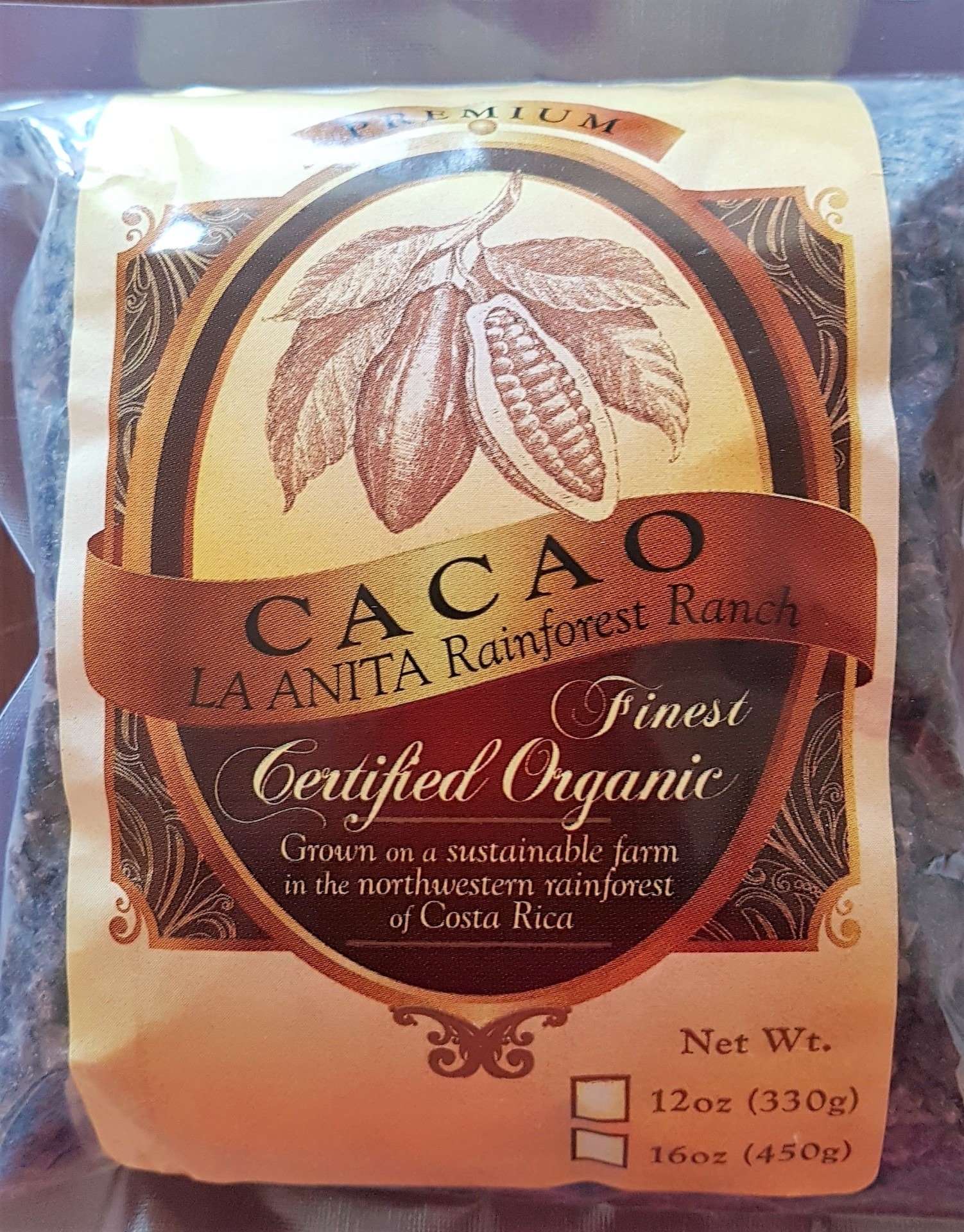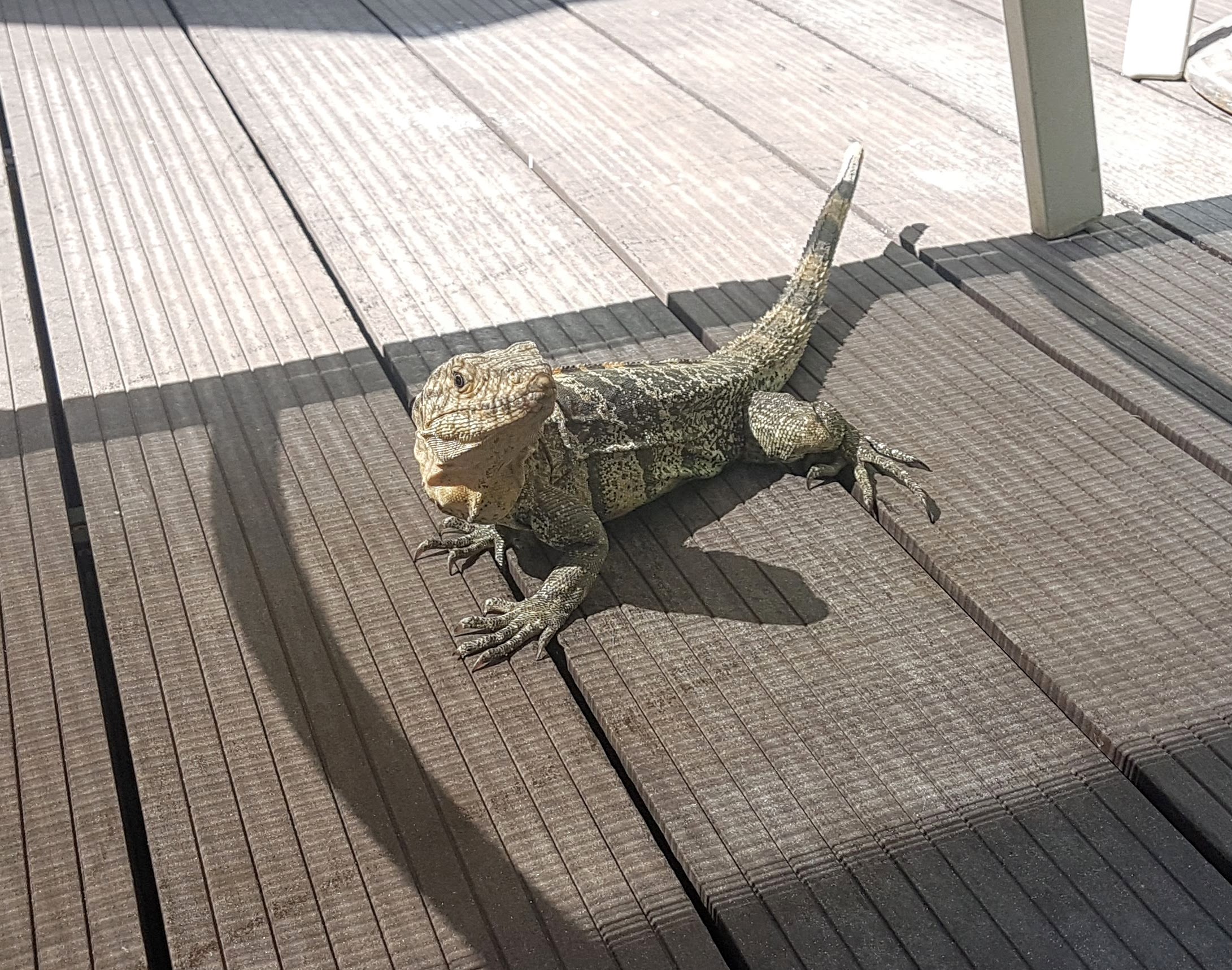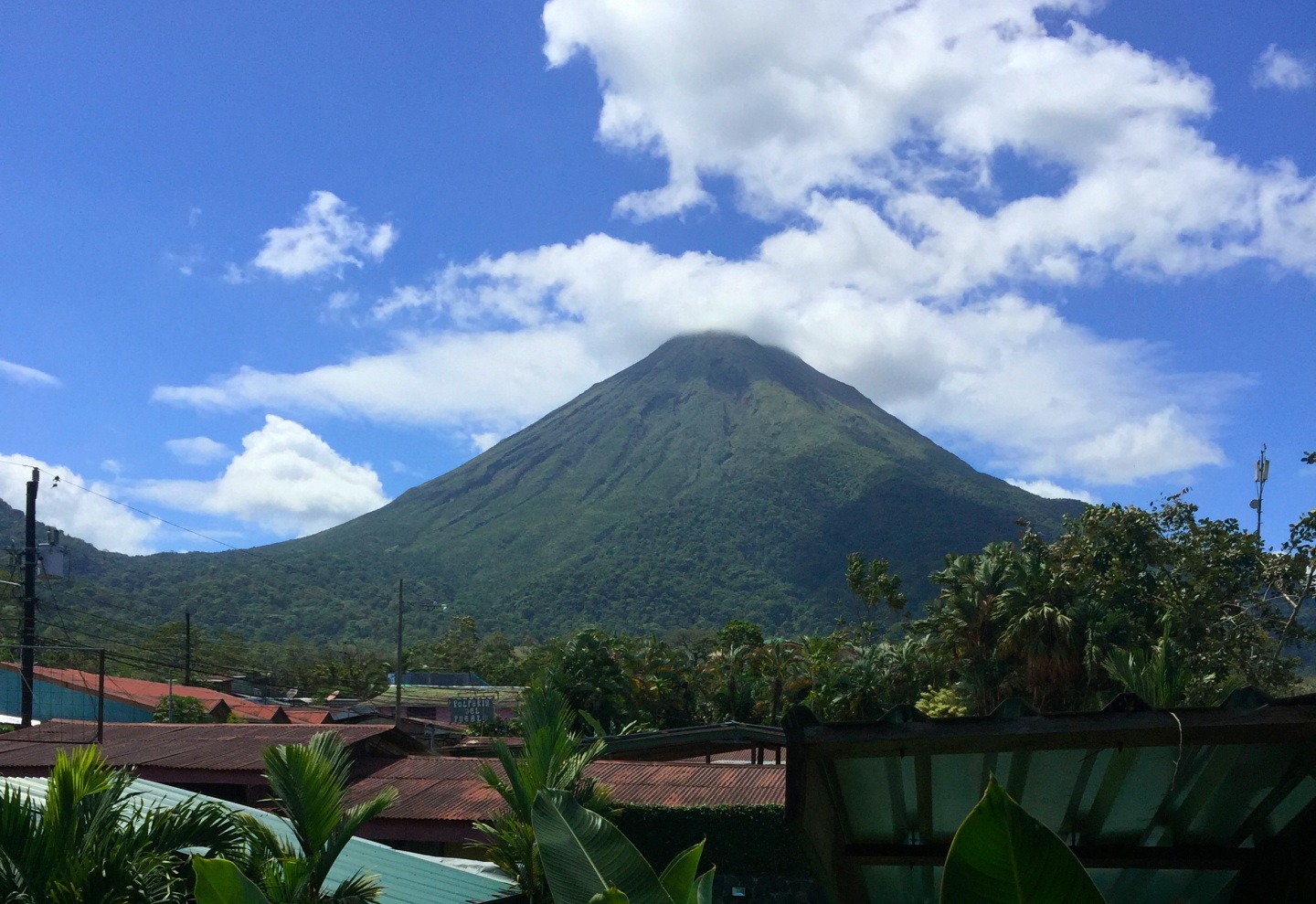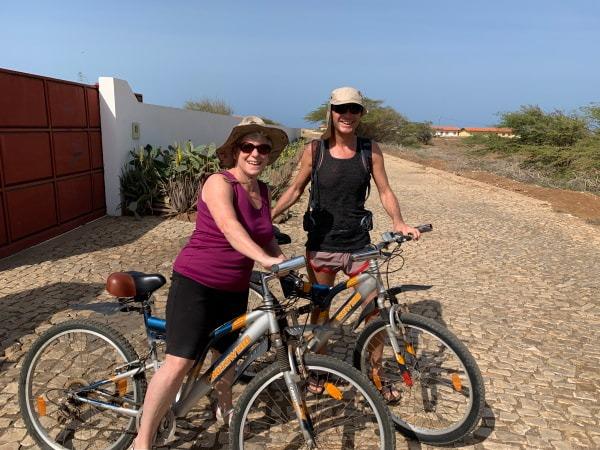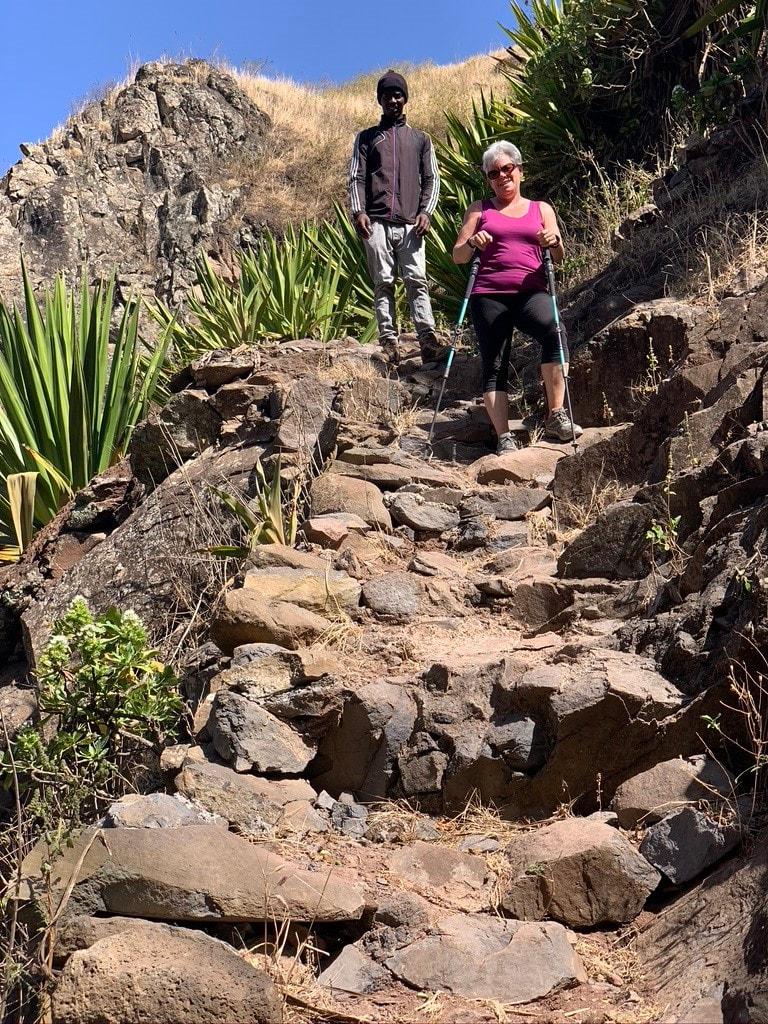February 12, 2019 – from La Fortuna to Anita Rainforest Ranch
Today we had a chance to “pay back” the kindness of the gentlemen who helped us with our flat tire the other day.
We had mistakenly taken a very bumpy gravel road through the mountains. There were some cattle grazing, but mostly the land was too rocky for farming. The few houses we passed looked far from prosperous. In front of one of them an old man with a few missing teeth waved us down. He explained that there was a sick baby in the house, and they needed us to take it and the mother to a nearby town so she could get to a doctor.
Being skeptical, and having heard about so many scams in many of the countries we’ve traveled, we hesitated. But then the baby’s worried looking father came over and showed us a picture of the baby and repeated the story. He’d follow along on his motor bike, but couldn’t transport the mom and 2-month old that way. Convinced, we told him to go get the mom and baby; we had just enough room for them in the back seat next to our luggage. The baby was listless, and didn’t make a sound the whole way there.
It was a bit of a detour but we got them to a shabby run-down house in the next village, where the mom asked us to stop. Dad pulled up on his motorbike as I was helping them out. Hard to imagine that a doctor lives there; we are assuming that they had a friend there who had a vehicle that could take them to a town with an actual clinic. Either way, they seemed grateful for the ride.
We continued our drive. After hours spent driving through dusty villages and poor farmland on a rough gravel road, we finally found La Anita Rainforest Ranch.
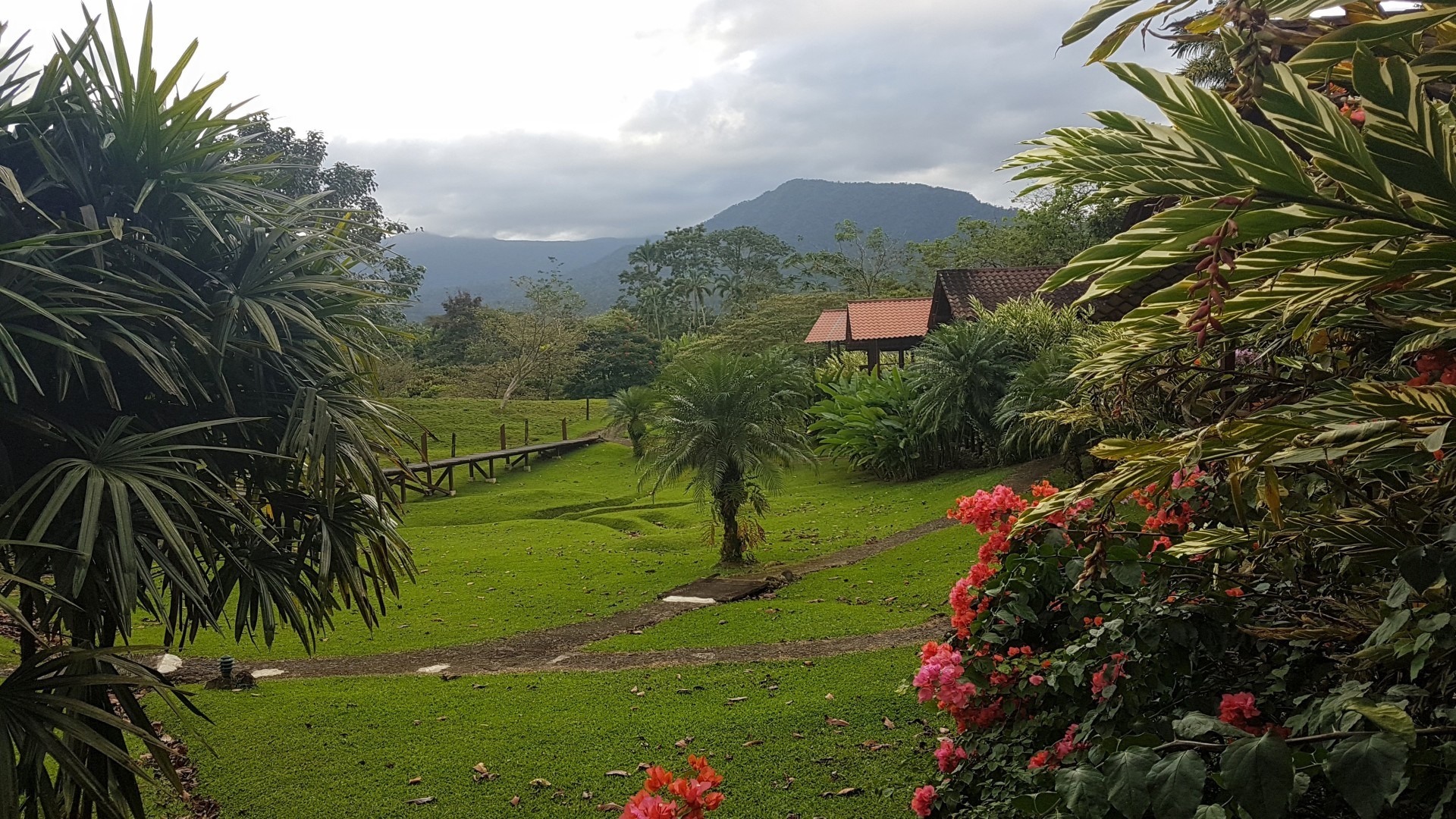
Driving in, we felt like we’d entered another dimension. Lush, beautifully manicured lawns, birds of many varieties chirping, a beautiful white horse in a pasture, cocoa trees and brightly coloured flowering bushes all over.
We were greeted by one of the owners, Pablo Cespedes, and immediately offered local coffee or juice. We chose the latter. I’m not sure what the purple fruit was, but it was delicious. Then Pablo gave us a little tour and told us the house rules: breakfast is at 7:30, dinner at 6:00. None of this “between 7 – 10” nonsense; the cooks are local ladies who have to get back to feed their own families. They can’t be hanging around all day.
There are 13 cabins on the property, designed and placed in such a way that you have total privacy in each one. From your shower you look out at the jungle, with just a screen protecting you from insects. There are windows (with good screens) on every side of the cabin, a comfy bed, modern plumbing, and a deck with a clean hammock and rocking chairs. What a place to relax!
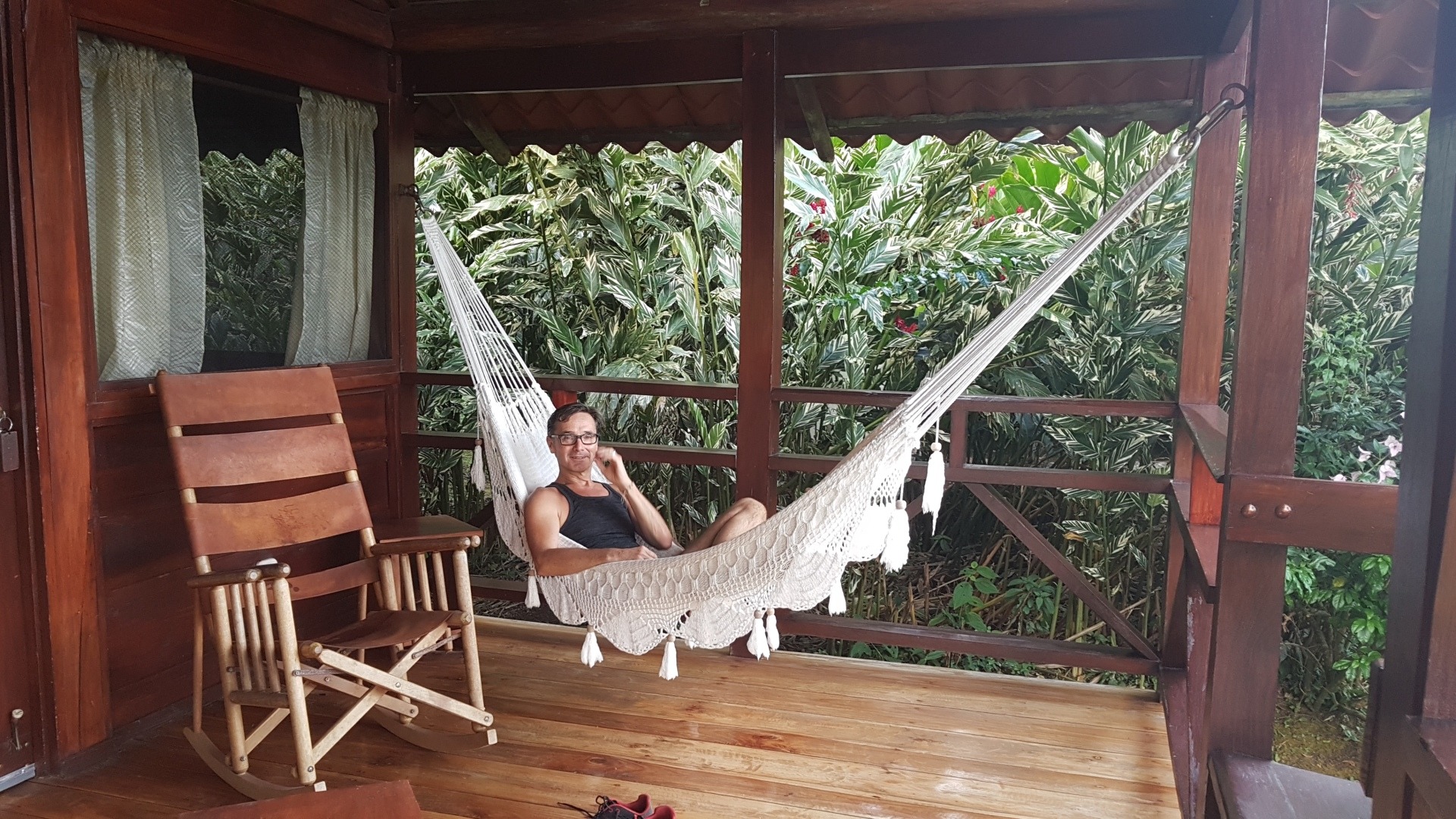
We went for a walk beside a river, and found a place where three rivers meet. It was the perfect spot to jump into the pools and cool down. (We didn’t, at that point, know about all the poisonous snakes wandering around. Fortunately, we didn’t meet any!)
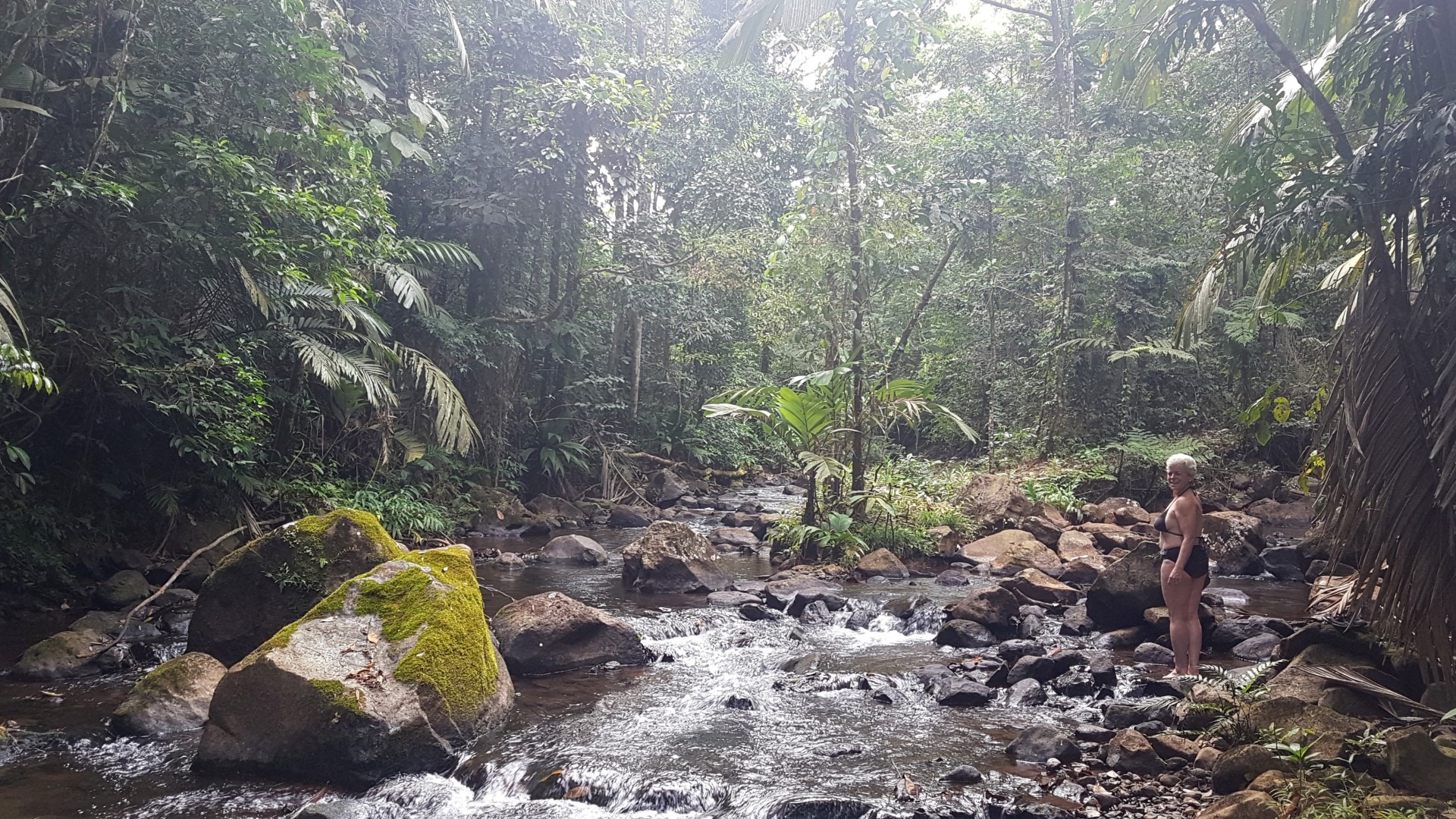
Then back to our beautiful cabin for a shower and off to dinner.
It turned out we were the only ones there for dinner that night; a batch of visitors had just left. So we invited Pablo over to chat with us, and I slipped into my interviewer mode.
The property was a failing macadamia nut farm when he and his wife scraped together all their financial resources and bought it in 2002. She was pregnant with their first child. It was a big risk. They’d studied agribusiness and marketing, and realized that the economics of macadamia production were such that it could no longer be profitable in Costa Rica. Even in Hawaii, he says, where they do a great job of marketing themselves as macadamia nut producers, a lot of what they sell is no longer grown there; it comes from Australia, which is now the one place where it makes sense to grow the crop.
Interest in quality cocoa, however, was just starting to emerge. They caught the wave at the right time: it is now growing faster than gourmet coffee or wine. They switched to cocoa production, hired the best local workers and explained to them why the switch and the importance of doing things right. Their goal from the start has been to produce a premium product. They have frequent educational sessions so that everybody understands how their work fits into the process and why attention to detail is so important.
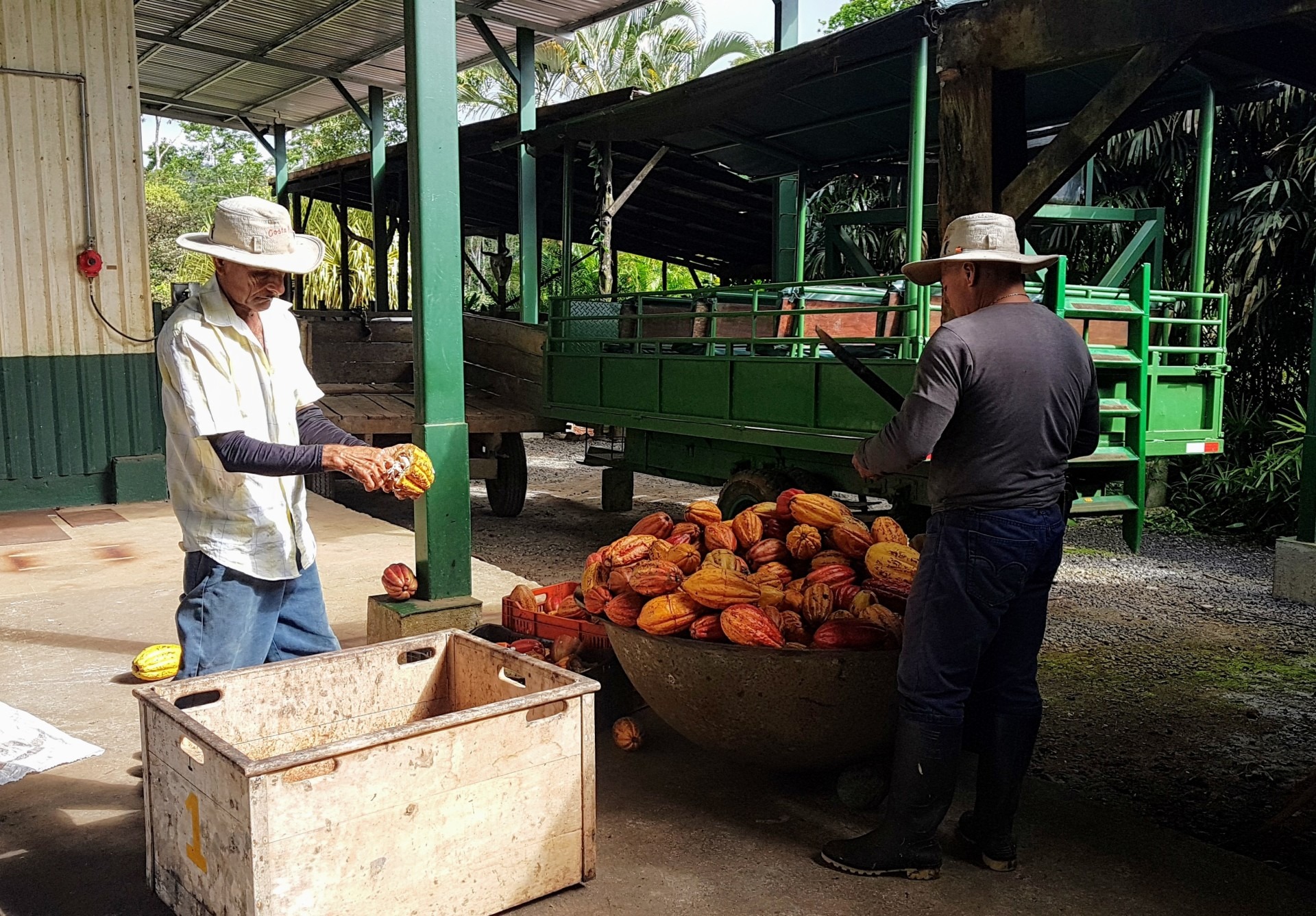
They currently have 11 locals working at the farm, and they are all cross-trained. If things are particularly busy on the cabin rental side, people can be pulled off production lines and over to serving guests. At busy production times, they can go the opposite direction.
At the moment about 45% of their revenue comes from cocoa sales; the rest is from the tourists, but they are working to reverse that ratio. They are happy to have a few guests, but have no desire to expand that side of the business. What really interests them is the potential for growth in cocoa export sales. They have chosen to sell directly rather than through middlemen, and have clients in North America and Europe. Recently they put up a website, in the hopes of expanding their global markets that way.
Unfortunately we weren’t staying long enough to witness the production process, but we did get to see the first steps. Pablo pointed out every detail to show the quality of what they do. Even down to not using machetes to cut the pods off the trees, but instead using scissors. Machetes are too likely to injure the trees and prevent regrowth at those spots.
The harvested pods come in red, orange and yellow. The red and orange ones are the best. Because the batch that had just been harvested (490 pods) was mostly those colours, he plans to turn this into a “reserve” batch, to sell at a higher price to the true connoisseurs.
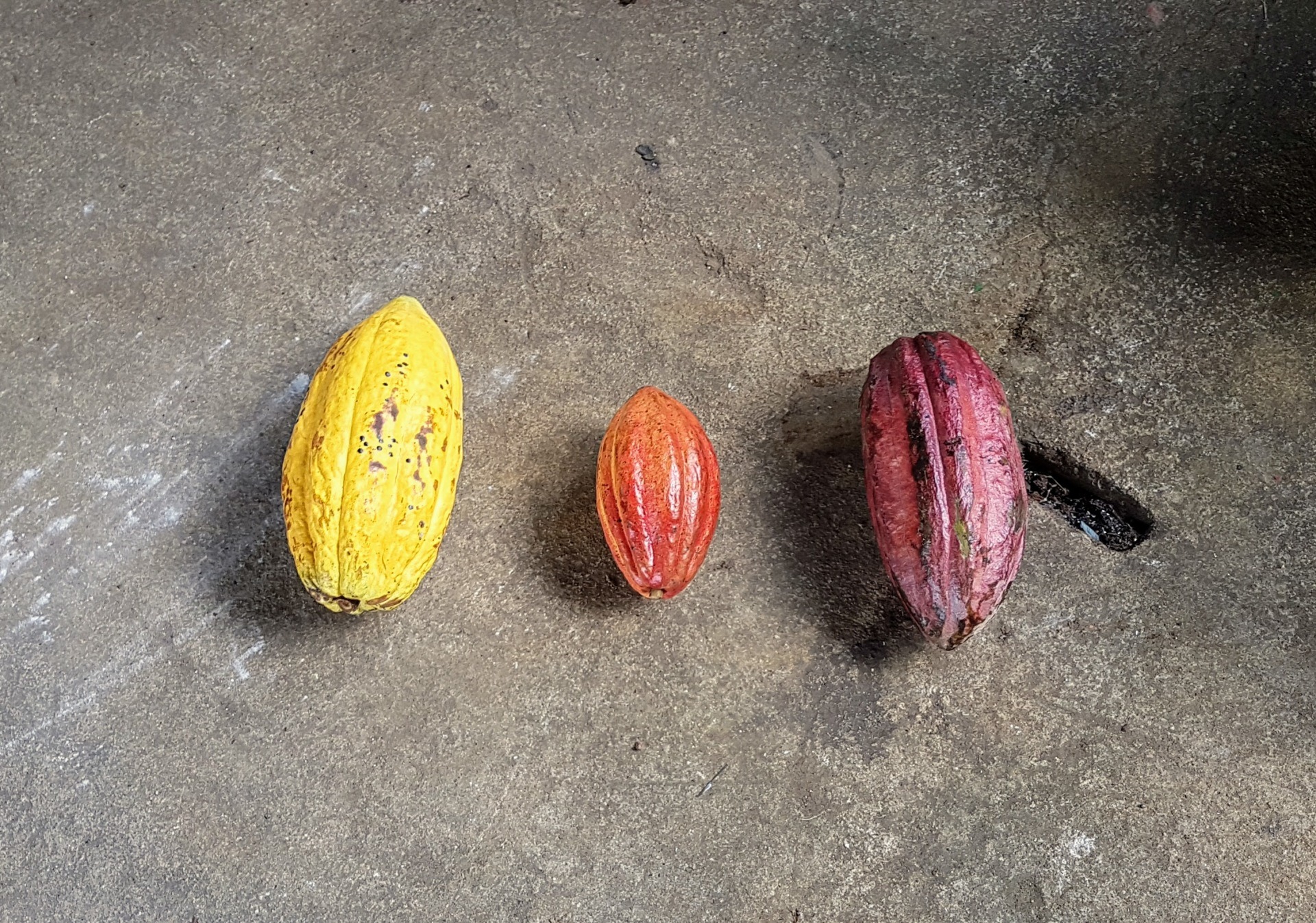
The pods are cracked open with a few taps of a machete, followed by splitting them by hand. Then the beans are gently stripped out, being careful not to include the “placenta”, which would degrade the purity of the batch. The beans, which are covered in a slick white coating, are put into fermentation bins for eight days. The balsa wood fermentation bins must have rounded corners, and no metal that could come into contact with the contents. The workers may not wear any perfumes or lotions on their hands, as that could affect the flavor of the cocoa.
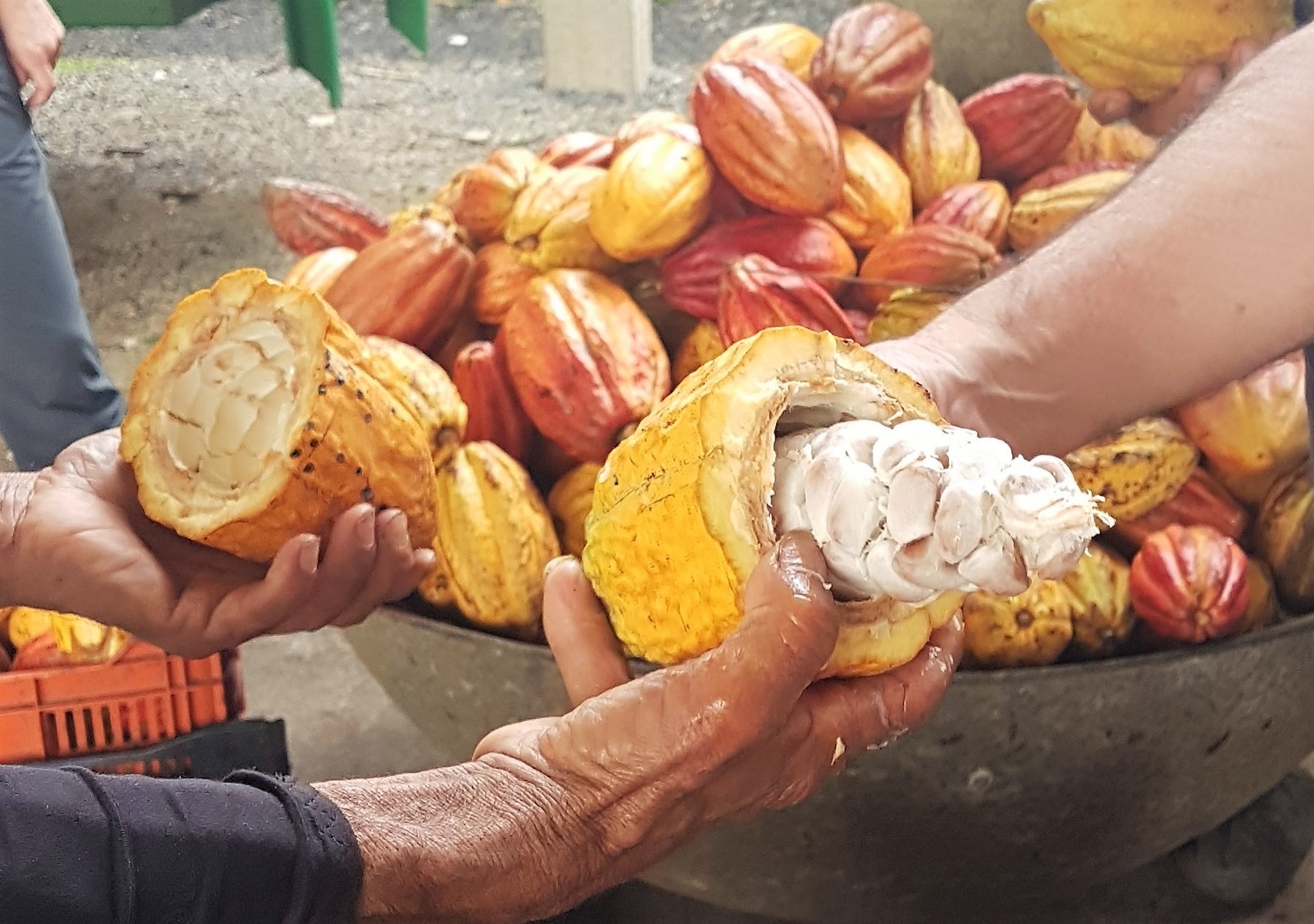
Any pods that look less than perfect are put aside for further examination. For example, a couple of them had holes drilled by woodpeckers. They will be opened separately to make sure the holes weren’t deep enough to expose the beans to any contamination. Nothing but the best goes on to the fermentation stage. The rest just goes to compost.
The issue of quality came up over and over again. It all affects the flavor of the final product. Dark chocolate should taste strong, but not bitter. If it tastes bitter, shortcuts have been taken.
Steps in the Cocoa Making Process
- Harvest – 2 days (in a small, premium farm like this one)
- Fermentation – 8 days (the beans are covered with palm tree leaves)
- Drying – 12 days
- Roasting – 15 minutes
- Peeling & breaking into nibs – 2 hours
- Conching – the process that makes it all smooth
What To Do With Cocoa Nibs
It is amazing all the things you can do with crunchy little cocoa nibs. Our first night there dessert consisted of a lovely creamy rice pudding sprinkled with cocoa nibs on top. Looked pretty and gave a nice little burst of flavour and texture. Another night they were sprinkled on a flan. They are also great mixed into granola or trail mix, or mixed with yogurt. They’d probably be good baked into cookies. Or just eaten on their own.
